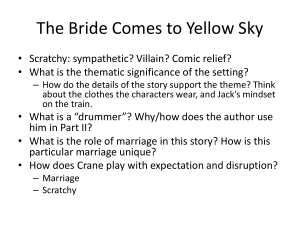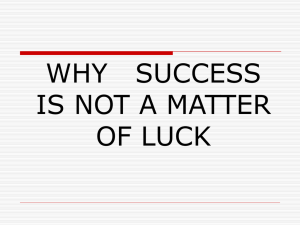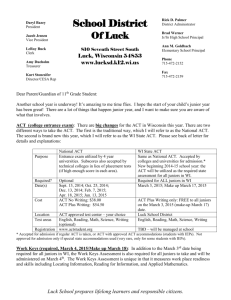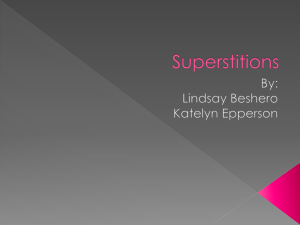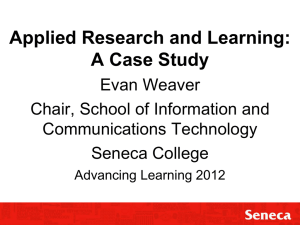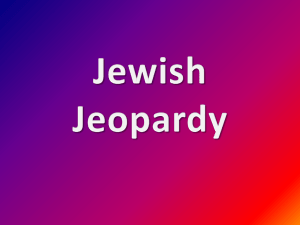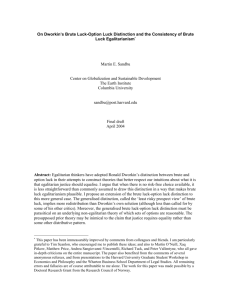Seminaressay Monday 11 April
advertisement
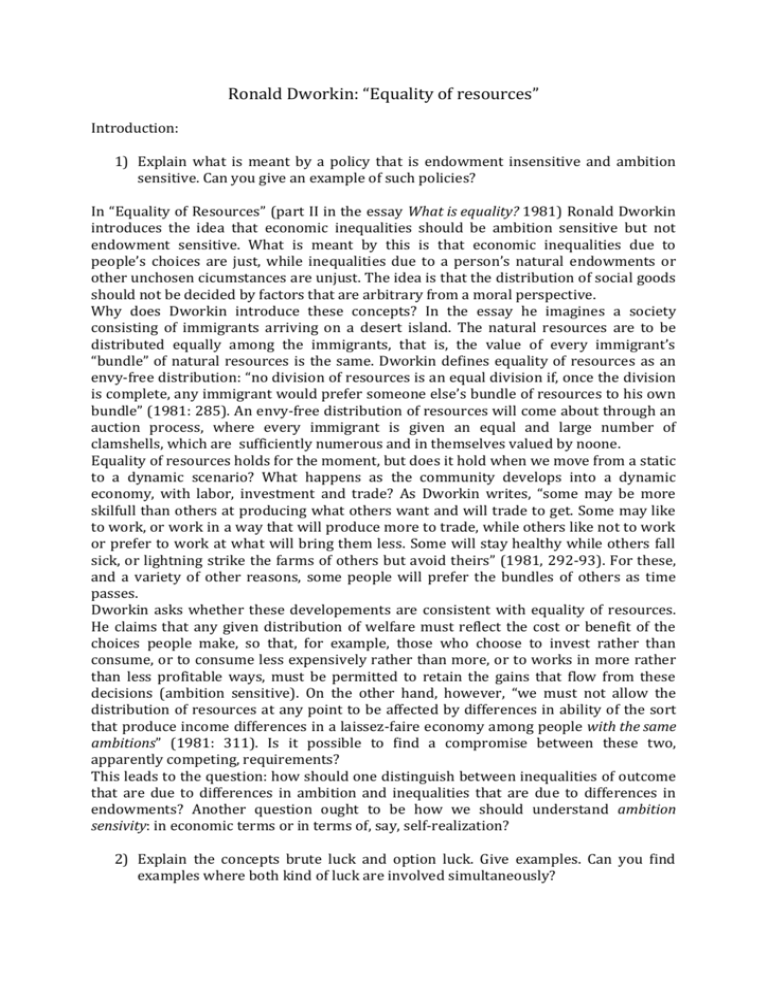
Ronald Dworkin: “Equality of resources” Introduction: 1) Explain what is meant by a policy that is endowment insensitive and ambition sensitive. Can you give an example of such policies? In “Equality of Resources” (part II in the essay What is equality? 1981) Ronald Dworkin introduces the idea that economic inequalities should be ambition sensitive but not endowment sensitive. What is meant by this is that economic inequalities due to people’s choices are just, while inequalities due to a person’s natural endowments or other unchosen cicumstances are unjust. The idea is that the distribution of social goods should not be decided by factors that are arbitrary from a moral perspective. Why does Dworkin introduce these concepts? In the essay he imagines a society consisting of immigrants arriving on a desert island. The natural resources are to be distributed equally among the immigrants, that is, the value of every immigrant’s “bundle” of natural resources is the same. Dworkin defines equality of resources as an envy-free distribution: “no division of resources is an equal division if, once the division is complete, any immigrant would prefer someone else’s bundle of resources to his own bundle” (1981: 285). An envy-free distribution of resources will come about through an auction process, where every immigrant is given an equal and large number of clamshells, which are sufficiently numerous and in themselves valued by noone. Equality of resources holds for the moment, but does it hold when we move from a static to a dynamic scenario? What happens as the community develops into a dynamic economy, with labor, investment and trade? As Dworkin writes, “some may be more skilfull than others at producing what others want and will trade to get. Some may like to work, or work in a way that will produce more to trade, while others like not to work or prefer to work at what will bring them less. Some will stay healthy while others fall sick, or lightning strike the farms of others but avoid theirs” (1981, 292-93). For these, and a variety of other reasons, some people will prefer the bundles of others as time passes. Dworkin asks whether these developements are consistent with equality of resources. He claims that any given distribution of welfare must reflect the cost or benefit of the choices people make, so that, for example, those who choose to invest rather than consume, or to consume less expensively rather than more, or to works in more rather than less profitable ways, must be permitted to retain the gains that flow from these decisions (ambition sensitive). On the other hand, however, “we must not allow the distribution of resources at any point to be affected by differences in ability of the sort that produce income differences in a laissez-faire economy among people with the same ambitions” (1981: 311). Is it possible to find a compromise between these two, apparently competing, requirements? This leads to the question: how should one distinguish between inequalities of outcome that are due to differences in ambition and inequalities that are due to differences in endowments? Another question ought to be how we should understand ambition sensivity: in economic terms or in terms of, say, self-realization? 2) Explain the concepts brute luck and option luck. Give examples. Can you find examples where both kind of luck are involved simultaneously? In the article referred to above Dworkin distinguishes between two kinds of luck. He claims that option luck is a matter of how deliberate and calculated gambles turn out – whether someone gains or loses through accepting an isolated risk he or she would have anticipated and might have declined. Brute luck, on the other hand, is a matter of how risks fall out that are not in that sense deliberate gambles. Dworkin refers to examples such as that if he buys a stock on the exchange that rises, then his options luck is good. If he gets hit by a falling meteorite whose course could not have been predicted, then his bad luck is brute. As I understand it option luck is something a person deliberately can avoid, while brute luck is due to circumstances that you cannot control. It is sometimes difficult to describe a piece of bad luck exclusively in terms of option luck or brute luck. If a person who gets cancer has smoked during her life, we might consider it as option luck. If a person who hasn’t smoked gets cancer we might consider it as brute luck. There are several examples where both kind of luck are involved simultaneously. A friend of mine recently experienced a break-in. Many valuable items were stolen, among others his computer, his digital reflex camera with several lenses, his mp3-player. My friend had, however, got an insurance some months earlier, and in this way he got compensated for the economic loss he had suffered. It was brute luck that someone broke into his apartment, but it was option luck that he had an insurance once he was in that situation. This example illustrates that insurance provides a link between brute and option luck, because the decision whether to get one or not is a calculated gamble. Why does Dworkin introduce these concepts? Dworkin asks whether or not it is consistent with equality of resources that people should have different income or wealth in virtue of differing option luck. If some of the immigrants plant valuable but risky crops while others play it safer. Dworkin also argues that one must compare the situation of those who gamble and win with that of those who gamle and lose. The capability approach “…wealth is evidently not the good we are seeking; for it is merely useful and for the sake of something else”. In the following I will discuss the concepts capability and functioning, and I will give examples. I have chosen to answer the questions The core costituents of the capability approach are capabilities and functionings. 1) What is the difference between capability and functioning? Amartya Sen uses the term capability to refer to a person’s ability to do valuable acts or reach valuable states of being. The term capability is meant to represent the alternative combinations of things a person is able to do or be, or the various functionings he or she can achieve. According to Sen “functionings represent parts of the state of a person – in particular the various things that he or she manages to do or be in a leading life. The capability of a person reflects the alternative combinations of functionings the person can achieve, and from which he or she can choose one collection”1. In other words a functioning is an achievement of a person or states and activities that are constitutive of a person’s being. A capability reflects a person’s ability, or even freedom, to achieve a given functioning. It follows that the freedom to lead different types of life is reflected in the person’s capability set, i.e. the set of attainable functionings a person can achieve. The capability approach evaluate a person’ advantage in terms of his or her actual ability to achieve various valuable functionings as a part of living: we must consider how well people are able to function with the goods and services they have available. The capability approach is a liberal one, and its proponents argue that each person must decide for herself what she wants to make of her life. People may therefore freely choose not to exercise their capabilities of functionings: the point is that such a decision should be a free choice. Starving may be used as an example to illustrate the difference between capability and functioning. Consider two persons who don’t eat enough to enable the functioning of being well-nourished. The first person suffers in a famine in India, and the other person has decided to go on a hunger strike for some political cause. Even though both persons lack the functioning of being well-nourished, the freedom (or capability) they had to avoid being hungry is distinct in the two cases. Neither of the persons has achieved the functioning of being well-nourished, but the protester who decided to go on a hunger strike had the capability to achieve this functioning while the other person didn’t. Another way of examining the difference between capabilities and functioning is, as Bojer suggests, by stating what they are not. They are not personal welfare, nor a collection of economic goods, like income and wealth, nor resources. The focus of the capability approach is rather on what we are able to do with our resources and wealth. 2) Give an example of a functioning and corresponding capability. Functioning: Go to church Capability: Freedom of religion 3) Marta Nussbaum proposes a list of important capabilities. Do you agree with the list? Would you remove some and introduce others? Can you suggest which policies would promote one or more of them? Marta Nussbaum has proposed a list of ten capabilities. The list is generated by asking the question: “What activities characteristically performed by human beings are so central that they seem definitive of a life that is truly human?” Or, “what are the functions without which we would regard a life as not, or not fully, human?”. Nussbaum has proposed the following list over central human functional capabilities: 1) Life 2) Bodily health and integrity 3) Bodily integrity 4) Sense, imagination, thought In his essay “The Standard of Living” (1987) Sen writes that “a functioning is an achievement, whereas a capability is the ability to achieve. Functionings are, in a sense, more directly related to living conditions, since they are different aspects of living conditions. Capabilities, in contrast, are notions of freedom, in the positive sense: what real opportunities you have regarding the life you may lead”. 1 5) Emotions 6) Practical reason 7) Affiliation 8) Other species 9) Play 10) Control over one’s environment a. Political b. Material Nussbaum argues that “we cannot satisfy the need for one of them by giving a larger amount of the other one. All are of central importance and all are distinct in quality. ... thus, there is a tragic aspect to any choice in which citizens are pushed below the threshold in one of the central areas”. Further, Nussbaum distinguishes between basic, internal and combined capabilities (see Nussbaum, 1999: 44). The aim of public policy, she claims, is the production of combined capabilities, that is, “promoting the states of the person by providing the necessary education and care; it also means preparing the environment so that it is favourable for the exercise of practical reason and the other major functions” (Ibidem.) Do I agree with the list? Would I remove some (important capabilities) and introduce others? The capability approach may be seen as a critique of traditional welfare economics, which measure well-being either in income or utility. Neither opulence nor utility represent adequately human well-being and deprivation. I find the capability approach an intereseting one, precisely for this reason: it is an approach which focuses on directly on human functioning and the capability to achieve valuable functionings. Amartya Sen has chosen not to propose a list of valuable functionings. If the capability approach is accepted, Sen writes, a list will be determined by open, public debate and reflection. In my point of view the problem of the capability approach is exactly making such a list, or determining the central human functional capabilities. First, when we make a list it is almost as we implicitly define a standard for how a life should be lived for everyone (especially if the list is very broad). Second, some persons may from birth lack one or more of the central human capabilities (for example persons with cogniitive disabilities). Are their lives not, or not fully, human? I am not sure which elements I would remove or introduce to the list, as I find the idea of making such a list quite problematic. Policies that would promote one or more of them
